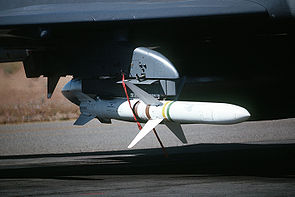AGM-45 Shrike
| AGM-45 Shrike | |
|---|---|
| General Information | |
| Type | Anti-radar missile |
| Manufacturer | Texas Instruments |
| Unit price | $ 32,000 |
| Technical specifications | |
| length | 3050 mm |
| diameter | 203 mm |
| Combat weight | 177 kg |
| span | 914 mm |
| drive | Solid rocket engine |
| speed | Do 2 |
| Range | 11-40 km |
| Furnishing | |
| Target location | Passive radar view |
| Warhead | 66.6 kg or 67.5 kg, highly explosive |
| Weapon platforms | Douglas A-4 , Grumman A-6 , Vought A-7 , McDonnell F-4 , General Dynamics F-16 , McDonnell Douglas F / A-18 , Republic F-105 , Avro Vulcan |
| Lists on the subject | |
The AGM-45 Shrike is an American tactical air-to-surface missile used to suppress enemy air defense . For this purpose it is designed as an anti-radar missile. Your seeker switches to the frequency of the enemy radar and uses this to hit the radar position.
The Shrike ( English for shrike - a species of bird) was developed in 1961 by the Naval Weapons Center in China Lake based on parts of the AIM-7 Sparrow and produced from 1963. The Shrike was built in various versions, which mainly differ in the frequency ranges used.
In the early 1970s, the rocket was developed into the AGM-45B Shrike . With a new engine it now achieved a range of 40 km.
It was used by the USA in the Vietnam War and by the Israeli Defense Forces in the Yom Kippur War and in 1982 in Lebanon, but in some cases it did not prove itself. During the Falklands War , some shrikes were made available to Great Britain which were used with some success in the course of Operation Black Buck .
By the end of production in 1982, a total of around 18,500 units had been produced. The United States Armed Forces replaced the Shrike in 1983 with its successor, the AGM-88 HARM . The Shrike has not been part of their inventory since 1991.
